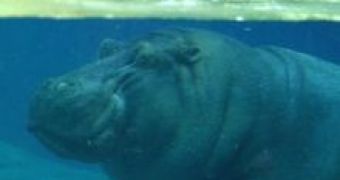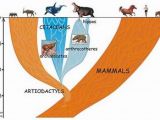Based on morphology studies, scientists have long believed that hippo's closest relative is the pig. This assumption witnessed a resounding rejection twenty years ago when molecular analysis, later on backed up by DNA analysis, showed that hippo's closet relative is in fact... the whale.
The problem since has been that there aren't any fossil evidences to back up this discovery. How did the common ancestor of hippos and whales look like?
The answer to this question was found by Jean-Renaud Boisserie from Berkeley University and his French colleagues Michel Brunet and Fabrice Lihoreau: the hippo's and whales' common ancestor was a quasi-aquatic mammal which has lived 50-60 million years ago and which has disappeared during an ice age.
This animal has given birth to two different groups: on one hand the cetaceans, which have gradually became entirely aquatic (whales, dolphins, orcas) and, on the other hand, a group of animals called anthracothers (which were wrongfully believed to be closely related to pigs). The anthracothers have existed for almost 40 million years and they were extremely diverse; the scientists classified them in 37 different groups. The anthracothers were spread all over the world except for South America and Oceania. Nevertheless, they have disappeared around 2.5 million years ago, leaving behind the hippo as their only remaining survivor. Today, the hippo itself is threatened by extinction. The hippos have appeared in Africa around 16 million years ago, and their number has witnessed an explosion around 8 million years ago.
The reason why archaeologists were mistaken for such a long time in regard to its origin was that they relied too heavily on morphological studies - i.e. studies on the structural similarities between various fossils. The most well preserved fossils are often jaws and teeth. Thus, scientists often based their classifications on studies conducted on jaws and teeth. However, as Boisserie remarked, the teeth do not provide such reliable information as scientists used to believe until recently. The reason is that teeth and jaws are often subjected to quick evolutionary developments, they adapt to the external condition fairly quickly. Thus, when one is interested in finding a long term evolutionary tree, jaws and teeth are not very trustworthy and they do not provide much information.
When genetic evidences have clearly shown that hippo's closest relative is the whale, biologists have begun to wonder whether they already have had the missing link's fossil but they simply didn't recognize it due to the fact that they weren't aware how to interpret the fossil evidences. What fossil similarities or dissimilarities are relevant and what aren't?
Boisserie's, an expert in hippos, and his colleagues' contribution was mainly that they have succeeded in reinterpreting the existing fossils. However, this endeavor was facilitated by the recent discovery in Pakistan of a hippo ancestor, an anthracother that lived around 9 million years ago. Here it is shown the photography of the anthracother's skull (above) and of a hippo's skull (below). The relevant morphological aspect is the shape of the eye sockets - this shape is such that the animal could see above the water while keeping his head almost entirely submerged.
Boisserie proposal places the cetaceans much closer to cloven hoof mammals (such as pigs, cows, sheep, camels, giraffes, and most of the land major mammals; these animals are called Artiodactyls) than they were considered until recently. "Our study shows that these groups [cetaceans and artiodactyls] are not as unrelated as thought by morphologists," Boisserie said. "Cetaceans [as well as anthracothers] are artiodactyls, but very derived artiodactyls." It thus seems that the common ancestor of hippos and whales was a four-footed, quasi-aquatic animal.
After this new analysis and reinterpretation of the fossil evidences, based on a reevaluation of what is relevant and what isn't relevant when we compare two fossils, the image offered by morphological study is once again compatible with the genetic evidences.
Photo credits: Aaron Logan; Anthracothere skull from Harvard University & Geological Survey of Pakistan; hippo skull from the Natural History Museum, London Image credits: Jean-Renaud Boisserie/UC Berkeley

 14 DAY TRIAL //
14 DAY TRIAL // 

